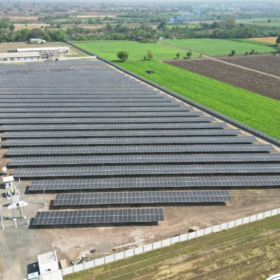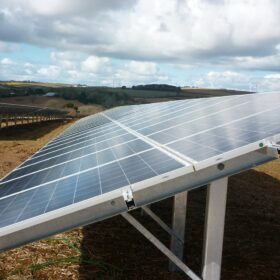The Indian Ministry of New and Renewable Energy (MNRE) has introduced a number of Central Financial Assistance (CFA) schemes to promote solar PV in India and achieve its ambitious 100 GW target by 2022. The support is aimed at providing subsidies to individuals or enterprises willing to contribute to growth.
Scheme: Solar Parks and Ultra Mega Solar Power Projects
CFA totaling INR 2 million per MW, or 30% of a project’s cost, including grid–connectivity costs, is available, depending on which is cheaper. An additional INR 2.5 million per plant is available for the preparation of Detailed Project Reports (DPRs) and conducting surveys, etc.
Current status: The scheme has been increased from 20 GW to 40 GW. As of January 11, 2018, 35 solar parks totaling 20.514 GW have been approved in 21 states.
Scheme: 300 MW of solar PV for defense establishments and paramilitary forces
Financing is made available though Viability Gap Funding (VGF), which is provided as a capital subsidy. Successful bidders are selected based on the lowest bids for these funds. A requirement is that developers must supply solar power at a rate of INR 5.50 ($0.086)/kWh for 25 years. Only domestic content can be used under this scheme.
VGF: Viability Gap Funding means a grant or subsidy to support projects that are economically justified but not financially viable. VGF grants will be available only for projects where developers are selected through a process of competitive bidding. The VGF will be disbursed at the construction stage itself but only after the private sector developer makes the equity contribution required for the project.
Earlier, the upper limit of VGF was varied, according to system size. However, considering technology upgrades and economies of scale, this was revised on February 17, 2017, to INR 11 million per MW for all projects irrespective of size.
Current status: 357.5 MW had been approved, as of July 31, 2017. Of this, 66 MW are under construction and 7 MW have been commissioned.
Scheme: Installing grid-connected solar PV power projects under Phase-II, with VGF support via SECI
Batch-I: 750 MW
Bidders are selected based on bids incorporating the VGF requirements, in ascending order. VGF is limited to 30% of a project’s cost, or INR 25 million per MW, whichever is lower.
The Solar Energy Corporation of India (SECI) has signed PPAs with project developers for purchasing the entire generated power for a 25 year period at INR 5.45 ($0.085)/kWh, and INR 4.75 ($0.075)/kWh for projects availing accelerated depreciation.
Current status: 680 MW have been commissioned across seven states.
Batch-III: 2,000 MW
The upper limit for VGF is kept at INR 10 million/MW for the open category and INR 13.1 million/MW for projects in the DCR category.
Current status: PPA has been signed for 2,295 MW across five states.
Batch-IV: 5,000 MW
The upper limit for VGF is kept at INR 10 million/MW for the open category and INR 12.5 million/MW for projects in the DCR category.
Batch-III and Batch-IV are also covered through big solar parks. Recently, SECI has launched 275 MW, 200 MW and 750 MW of tenders across three states.
Batch-V: 1,000 MW by Central Public-Sector Undertakings (CPSUs)
VGF at INR 10 million/MW for projects where domestically produced cells and modules are used and INR 5 million/MW in cases where domestically produced modules are used.
VGF to be released in two tranches as follows: 50% on successful commissioning of the full capacity of the project, and the remaining 50% after one year of successful operation of the project.
Current status: The entire 1,000 MW has been sanctioned. As of July 31, 2017, 444.5 MW has been commissioned.
Schemes for grid-connected Rooftop
CFA is 30% of the benchmark cost for general and 70% CFA for North Eastern and the Special Category States, for the residential, social and institutional sectors. No subsidy for the commercial & industrial (C&I) sector.
Schemes for development of grid-connected PV plants on canal banks and canal tops
Financial support of INR 30 million/MW or 30% of the project cost, whichever is lower, for canal top projects and INR 15 million/MW or 30% of the project cost, whichever is lower, for canal bank projects.
Total CFA of up to INR 2.25 billion for 100 MW (50 MW on Canal Tops and 50 MW on Canal Banks) to be disbursed over a period of a maximum two years post sanctioning of the plants as follows: up to 40% on the sanctioning of the projects, and 60% on the successful commissioning of the projects.
The service charge to SECI is 1% of the project cost.
Current status: As of 31.03.2017, an 8 MW canal top project and a 16 MW canal bank project has been commissioned.
Off-Grid schemes: PV lighting systems and power plants, solar pumps
A. Lighting systems.
- Home lights/lanterns/streetlights with lead acid batteries: Benchmark Cost = INR 340/W; CFA = INR 102/W
- Street lights with lithium ferro phosphate batteries: Benchmark Cost = INR 475/W; CFA = INR 142.5/W
B. Power packs with a battery bank at 7.2 VAh/W
- Up to 300 W: Benchmark Cost = 200/W; CFA = INR 60/W
- 300 W to 1 kW: Benchmark Cost = INR 135/W; CFA = INR 40.5/W
C. Solar Power plants with battery bank at 7.2 VAh/W and capacity up to 10 kW: Benchmark Cost = INR 135/W; CFA = INR 40.5/W
D. Solar Pumps
- Up to 3 HP (DC): Benchmark Cost = INR 120,000/HP; CFA = INR 30,000/HP
- 3HP to 5 HP (DC): Benchmark Cost = INR 95,000/HP; CFA = INR 19,000/HP
- Up to 3 HP (AC): Benchmark Cost = INR 100,000/HP; CFA = INR 25,000/HP
- 3HP to 5 HP (AC): Benchmark Cost = INR 85,000/HP; CFA = INR 17,000/HP
Current status: As of November 30 last year, more than 4.18 million solar lighting systems, 142,000 solar pumps, and power packs of 181.52 MW combined output have been installed across the country.
The government has provided several subsidies in solar, and companies are benefiting from this. However, the road to bring these subsidies to pass is often bumpy and hectic.
There are several issues reported thus far, including the small matter of how subsidies vary within each state, as some subsidies are not valid in particular states or persistent deviation from the CFA. Also, there is no single-point of contact and the whole process can take months and several rounds of office discussion before the final release.
Despite these difficulties, growth remains relatively undiminished, and India’s achievements are well known. The population and enterprises active in India believe that the country will have a better processing system in the coming years, although the proposed safeguard duty and import duty could add further doubt to the growth.
This content is protected by copyright and may not be reused. If you want to cooperate with us and would like to reuse some of our content, please contact: editors@pv-magazine.com.








can you provide information abot CFA for small rooftop plant from 1kw-100kw in state of maharashtra
I want to install sheet roof top Solar generation over my house
I want to materials required, cost, protective dealers or manufacturers information
My reply to the question raised by the above two writers.
Solar power in roof top of houses / Multi storey apartments is governed by policy of the state and Centre has no jurisdiction over it. Hence CFA is not admissible.
But State governments have given or extended several concessions. It is state specific and hence general answer cannot be furnished.
Please update me on Latest State and Central Policy for Solar Generation of 1MW Power for Commercial application in the State of HP.
I am an individual and want to venture out in Solar generation.
Please update me on Latest State and Central Policy for Solar Generation of 1MW Power for home application in the State of Karnataka.
How much subsidy is there for roof top domestic solar energy and Solar pump for agriculture in Himachal Pardesh ?